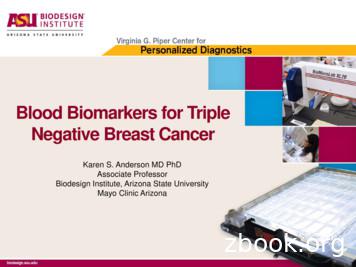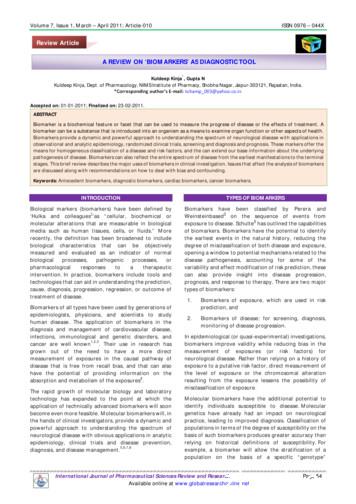Available And Emerging Biomarkers To Inform Decision .
Available and Emerging Biomarkers toInform Decision-Making for Patients withEarly-Stage Prostate Cancer (PC) andUse of Active SurveillanceRaoul S Concepcion, MDDirectorThe Comprehensive Prostate CenterNashville, Tennessee
DisclosuresConsulting AgreementsAstraZeneca Pharmaceuticals LP, Genomic Health Inc,Integra ConnectSpeakers BureauAmgen Inc, Astellas Pharma Global Development Inc,Bayer HealthCare Pharmaceuticals, DendreonPharmaceuticals Inc, Janssen Biotech Inc, Sanofi Genzyme
Prostate Cancer: Current Needs Refine PSA Increase the likelihood of an initial positive biopsy that will identifysignificant prostate cancer Reduce unnecessary repeat biopsies Stratify low risk from higher risk cancers Will PCMs (Prostate Cancer Markers) improve our management?3
PCMsTissueBloodWhat is a biomarker?A molecule that can be found in blood, tissueor body fluids that is a sign of a normal orabnormal processUrine4
Comparison of Molecular TestsProstate Cancer Molecular Test GridTestDescriptionGenomic ProstateScore (GPS)Predicts the likelihood of adverse pathologyusing multiple genetic pathwaysValidated Endpoint(s)Biomarker Selection Specificfor Prostate CancerAdverse Pathology at RPLikelihood of high-grade diseaseLikelihood of non-organ-confined disease5-year BCRNCCN Guidelines YESSpecimenPatient AccessPositive BiopsyMedicare Reimbursed for NCCN VeryLow/LowNCCN Very Low, Low, Lowintermediate riskGS 3 3, 3 4In a biopsy setting:Prolaris ProMark ConfirmMDx Decipher 4Kscore Cell Cycle Progression Score(CCP)10-year Untreated Mortalityin a post-RP setting:NOProstatectomy PositiveBiopsyFinancial Assistance Available: Patient contacted ifout-of-pocket 100Medicare Reimbursed for NCCN VeryLow/LowFinancial Assistance Available: Patient contacted ifout-of-pocket 375Reports the risk of dying from untreateddisease in 10 years, using a single pathway10-year BCRMetastasisNCCN Guidelines ProMark ScoreAdverse Pathology at RPPredicts likelihood of adversepathology using protein stainingLikelihood of high-grade diseaseLikelihood of non-organ-confined diseaseYESPositive BiopsyNegative Repeat BiopsyYESNegative Biopsy HGPINBiopsyMedicare Reimbursed Financial Assistance5-year MetastasisYESProstatectomyMedicare Reimbursed Financial AssistanceLikelihood of GS 3 4 and higher atbiopsyYESConfirmMDx resultPredicts likelihood of negative repeatbiopsyGenomic ClassifierPredicts the probability of metastasis aftersurgery4KscoreProvides probability of aggressive cancerAUA Low-High RiskGS 3 3, 3 4pT3 or pT2 w/positive marginBloodBiopsy-eligible patientsFinancial Assistance Available: Patient contacted ifout-of-pocket 350Available: Patient contacted if out-of-pocket 500Available: Patient contacted if out-of-pocket 395Financial Assistance is not reported on website
Oncotype DX Biopsy-based, 12 prostate cancer-specific genestest that has been clinically validated to predictthe likelihood of adverse pathology usingmultiple genomic pathways, allows betterpersonalized risk stratification to determinewho is best suited for active treatment vsactive surveillance Using the original needle positive biopsyVERY LOWLOWINTERMEDIATEMoreLessLikelihood of favorable pathology Test independently predicts: Likelihood of high-grade disease Likelihood of non-organ-confined disease Biochemical recurrence after RP Genomic Prostate Score from 0 to 100 Covered by Medicare for qualified patientsKlein, et al. Eur Urol. 2014.Cullen, et al. Eur Urol. 2014.
Gene Selection for the OncotypeGPS Assay727 candidate genes inhighest Gleason samples727 candidate genes indominant Gleasonsamples374 genes predictoutcome(dominant) DX288 genes predictiveregardless of sampledGleason pattern367 genes predictoutcome(highest)288 Genes Consistent performance in biopsies Predict PC death, adv. path, BCR Value beyond existing measures Represent key pathways Analytical performanceFinal 17 GPS GenesPC, prostate cancer; BCR, biochemical recurrence.8
GPS Incorporates Multiple Biologic PathwaysPredictive of Prostate Cancer AggressivenessGenes Associated with WorseOutcomeGenes Associated with BetterOutcomeStromal ResponseBGNCOL1A1SFRP4Androgen erence GenesARF1ATP5ECLTCCellular OrganizationFLNCGSNGSTM2TPM2The combination ofmultiple pathwaysis morepredictive thanany single pathwayGPS1PGK19
CCP Score Adds Significant Prognostic InformationMultivariate model*StudyEndpointHazard ratio(95% CI)CCP scorep-valuePSAp-valueGleasonScorep-valueTURP conservativelymanagedCaP death2.6 (1.9, 3.4) 10-10 10-70.028Needle Biopsyconservatively managedCaP death1.7 (1.3, 2.1) 10-40.0170.0022Rad Prostatectomy 1BCR1.7 (1.4, 2.2) 10-5 10-80.015Rad Prostatectomy 2BCR2.0 (1.4, 2.8) 10-40.120.17External Beam XRTBCR2.1 (1.0, 4.2)0.0350.0540.20
Prolaris Uses 31 cell cycle-related genes Predicts disease-specific mortality and disease aggressiveness in prostate cancer patients following needle biopsy Post-prostatectomy patients to better estimate the risk of biochemical recurrence Prolaris score is combined with patient’s clinical-pathologic values to estimate a 10-year prostate cancer-specific mortality risk Endpoints of aggressiveness, mortality risk and US distribution percentile Validated in relevant endpoints: BCR, metastasis, DSM Scores from 0 to 10 AS zone for helping with AS decision in untreated patients Prolaris Biopsy covered by Medicare for qualified patientsKoch MO, et al. Cancer Biomark. 2016;17(1):83-88.
ProMark Proteomic assay utilizing automatedimage analysis technology that identifiestumor and benign tissues Measures the quantitative expressionlevels of eight protein biomarkers- DERL1, CUL2, SMAD4, PDSS2, HSPA9, FUS,pS6, YBOX1 Patients with biopsy Gleason Scores 3 3and 3 4 Identify tumor aggressiveness Scores from 0 to 100 Covered by Medicare for qualifiedpatients
Decipher Localized prostate cancer Uses a biopsy to calculate the prognosis to determine if active surveillance, local therapy or multi-modal therapy is needed Based on the patient’s personal tumor-based genomics Post radical prostatectomy Uses the expression of biomarkers to calculate the probability of clinical metastasis within 5 years of radical prostatectomysurgery Analyzes a small tissue sample that was removed during surgery Predicts probability of metastasis after surgery and provides independent assessment of tumor aggression Measures the expression levels of 22 RNA biomarkers involved in multiple biological pathways across the genome that areassociated with aggressive prostate cancer Endpoints of probability of high grade disease, 5-year probability of metastasis and 10-year probability of prostate cancer specificmortality Decipher Score 0 – 0.45 Low Risk 0.45 – 0.6 Average Risk 0.6 -1 High Risk Covered by Medicare for qualified patients post-RPKarnes RJ, et al. J Urol. 2013. 190(6):2047-2053.
What is Decipher Biopsy?Classifies men into Decipher High or Lowgenomic risk for:1.% likelihood High Grade Disease (Gleason 4 or 5)2.% likelihood of Metastasis 5 years post prostatectomy3.% likelihood Prostate Cancer Specific Mortality (PCSM)10 yearsPatient Inclusion Criteria:ØØØØNCCN Very Low RiskNCCN Low RiskNCCN Intermediate RiskNCCN High Risk
Decipher Biopsy has predictive value forvarious endpoints (Feb 2016 - May 2017)PublicationInstitutionKlein et al., Urology 2016 Cleveland ClinicLee et al., UrologyResearch & Reports 2016UCSDNguyen et al., PCPD 2016DanaFarber/HarvardNguyen et al., EuropeanUrology, 2017Multiple (UCSF,Cleveland Clinic,JHU more)Patients (n)Primary Objective/Key Results57 patientsDecipher was shown to predict risk of metastasis 10 years post RP using needle biopsy tissue. Decipher had the highestAUC (0.80; 95% CI, 0.58-0.95) compared to NCCN (0.75; 95% CI, 0.64-0.87) at predicting 10 years post-RP metastasis.The AUC was 0.88 when Decipher was combined with the NCCN model. Pre-operatively, 40% and 47% of patients wereNCCN low and intermediate risk, respectively. Decipher categorized 67%, 25% and 9% of patients as low ( 0.45),intermediate (0.45-0.60) and high, respectively. Furthermore, Decipher reclassified 48% of NCCN intermediate risk menas low.22 patientsDecipher was shown to predict the presence of lymph node involvement (LNI) upon radical prostatectomy. Decipherhad an AUC of 0.78 for predicting LNI, significantly higher than Gleason score, pathological stage and preoperative PSA(all AUC 0.7). On MVA, for every 10% increase in Decipher score, the odds of having LNI on RP increased by 43%. Theconcordance between the biopsy Decipher and RP Decipher risk groups was 86%.100 patientsStudy suggests that patients with the highest GC risk (GC 0.6) had high rates of metastasis despite multi-modal therapyand could be considered for longer duration ADT and/or clinical trials. The Decipher genomic classifier’s (GC) ability topredict distant metastases after radiation and short-course androgen deprivation therapy (ADT) using needle biopsytissue was explored. 100 patients (NCCN intermediate and high risk) received RT [median] 6mo ADT. GC significantlyand independently predicted metastasis (HR. 1.41 on MVA) and performed with a c-index of 0.77.235 patientsBiopsy Decipher was a significant predictor of PCSM with a 5-year PCSM rate as well as 5-year metastasis. Patients withbiopsy Decipher low-, intermediate- and high-risk had a metastasis rate of 4.1%, 7.8% and 21% by 5 years post-biopsy.The risk of 5 year PCSM was 0%, 0%, and 9.4% for Decipher low, intermediate, and high, respectively (HR 1.57 56 per10% increase in score, 57 95% CI 1.03-2.48, P 0.037).
Uses a biopsy to calculate the prognosis to determine if active surveillance, local therapy or multi-modal therapy is needed Based on the patient’s personal tumor-based genomics Post radical prostatectomy Uses the expression of biomarkers to calculate the probability of clinical metastasis within 5 years of radical prostatectomy
biomarkers that may predict sensitivity to immunotherapy is an area of active research. It is envisaged that a deeper . and emerging technologies showing promise for deeper profiling and insights. Biomarkers and immunotherapy modalities Peripheral immune-based biomarkers . † Uses millions of short reads (sequence strings), so all RNA in a .
Uses of Biomarkers in Cancer Medicine . . There is an emerging set of blood biomarkers for cancer that have potential for early detection, prediction, and prognosis The challenge of new biomarkers is validation and integration with existing clinical detection methods .
a variety of tissue biomarkers and ancillary techniques (eg, immunohistochemical [IHC] analysis or fluorescence in situ hybridization) are currently available. In fact, hundreds of tissue biomarkers are available in clinical laboratories for diagnosing melanoma and determining the prognosis and mutation status of this devastating skin disease.
uses of cancer biomarkers as surrogate markers for drug . Emerging cancer biomarker types and the increasing interest in circulating tumour cells, as well as data on potential DNA, RNA, and protein biomarkers under study, includes Oncogenes, Germline inheritance, Mutations in drug targets, Epigenetic changes. .
quick response to intervention would allow for shorter trials for fully vetted biomarkers. The criteria above were developed for research stud-ies in humans. Foundational efforts to identify and cat-egorize the cellular and molecular Bhallmarks ofaging introduced a host of potential biomarkers for mammali-
Cancer Biomarkers In Australia 5 Executive summary BACKGROUND In cancer therapy, there has been a major shift from non-specific cytotoxic drugs that indiscriminately kill cells to targeted small molecules, monoclonal antibodies and immune regulators. At the same time, cancer biomarkers are increasingly being used for screening and diagnosis,
rationale for emerging biomarkers in this area. Hepatocellular carcinoma (HCC) is the fifth leading cause of death from cancer in men, the seventh leading cause of death from cancer in women, and the fastest Guruprasad P. Aithal Neil Guha
Lung cancer epigenetics: emerging biomarkers Lung cancer is the most common malignancy affecting both genders and remains the main cause of cancer-related deaths worldwide [1]. Only 13% of lung cancer patients survive more than 5 years. Lung cancers are classified according to histological types and this classification























